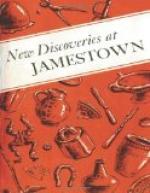But archeologists have found more than objects at Jamestown. They sought to unravel the mystery of that part of the first settlement which disappeared beneath the eroding current of the James River during the past 300 years. It has always been known that the island in the 17th century was connected to the mainland by a narrow isthmus extending to Glasshouse Point, where a glassmaking venture took place in 1608. Over this isthmus the “Greate Road” ran, and its traces have been discovered on the island as far as the brick church tower. As the isthmus disappeared at the close of the 17th century, the river continued to erode the island headward and build it up at its downstream end, so that the western and southern shores where the first settlement had been built, were partly destroyed. Thus, the first fort site of 1607, of which no trace has been found on land, is thought to have been eaten away, together with the old powder magazine and much early 17th-century property fronting on the river.
In a series of extensive tests for any possible trace of the 1607 fort still remaining on land, several incidental discoveries of importance were made. One was an Indian occupation site beneath a layer of early 17th-century humus, which, in turn, was covered by the earthen rampart of a Confederate fort of 1861. This location is marked today by a permanent “in-place” exhibit on the shore near the old church tower. Here, in a cut-away earth section revealing soil zones from the present to the undisturbed clay, evidence of 350 years of history fades away into prehistory.
Within the enclosure of this same Confederate fort was found a miraculously preserved pocket of 17th-century debris marking the site of the earliest known armorer’s forge in British America.
Just beyond, upriver, lie ruins of the Ludwell House and the Third and Fourth Statehouses. In 1900-01, Col. Samuel H. Yonge, a U.S. Army Engineer and a keen student of Jamestown history, uncovered and capped these foundations after building the original seawall. A strange discovery was made here in 1955 while the foundations were being examined by archeologists for measured drawings. Tests showed that no less than 70 human burials lay beneath the statehouse walls, and an estimated 200 more remain undisturbed beneath the remaining structures or have been lost in the James River. Here may be the earliest cemetery yet revealed at Jamestown—one so old that it was forgotten by the 1660’s when the Third Statehouse was erected. It is, indeed, quite possible that these burials, some hastily interred without coffins, could date from the “starving time” of 1609-10, when the settlers strove to dispose of their dead without disclosing their desperate condition to the Indians.
[Illustration: Jamestown exploration trenches of 1955 from the air. Landmarks are the “Old Cypress” In the river, upper left, the tercentenary Monument, and the standing ruin of the 18th-century Ambler house.]




